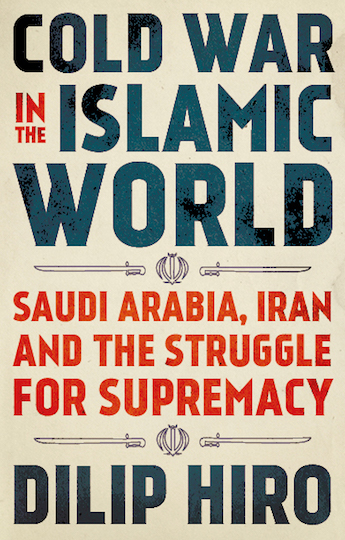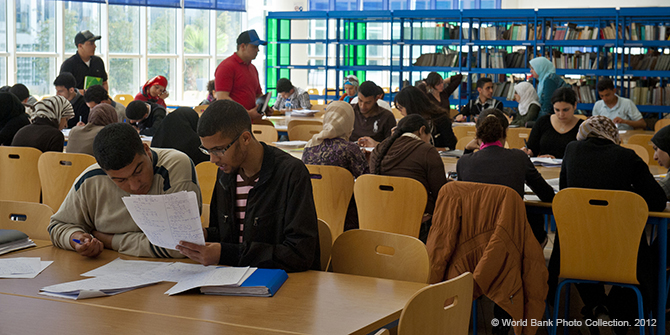by Simon Mabon
As the rivalry between these regional superpowers grows ever more fractious, a new book by the prolific Indian journalist Dilip Hiro seeks to explain this new cold war in its historical context. Simon Mabon finds much to admire in Hiro’s rich analysis and engrossing writing, though there is lack of engagement with the scholarly literature, depriving the reader of the broader analytic patterns that can help to understand the rivalry.
On 16 April 1947 Bernard Baruch, an adviser to President Harry S. Truman, gave a speech to the South Carolina House of Representatives at the unveiling of his portrait. In the course of his remarks, Baruch stated that ‘we are today in the midst of a Cold War’, the first time the term had been used to describe the increasingly sour relationship between the US and the USSR, two former allies.
In recent years, the concept has been revived to describe the rivalry between Saudi Arabia and Iran, two influential states occupying positions of geopolitical importance in the Gulf (Persian or Arabian depending on your language) who lay claim to leadership over the Islamic world. In the years after the 1979 revolution in Iran, the two states became embroiled in a rivalry that risked consuming the region, dividing it along sectarian lines. Although latent for a number of years, the rivalry has erupted in Iraq, Lebanon, Bahrain, Syria and Yemen, with devastating consequences. As a consequence of its escalation, a number of scholars have begun to explore this increasingly fractious rivalry. The latest piece of work has been undertaken by the prolific Indian journalist Dilip Hiro, an expert on Middle East politics and the author of a large number of books and opinion pieces on the topic, among others.
In Cold War in the Islamic World, Hiro offers a rich analysis of the rivalry between Saudi Arabia and Iran, dating back to the turn of the twentieth century. Spread across sixteen chapters, Hiro offers a genealogy of the rivalry and key moments across almost a century of enmity. It is packed with rich historical narratives and replete with anecdotes that leave the reader wanting more. There is a great deal to address, from the competition over ‘black gold’ to the withdrawal from the Joint Comprehensive Plan of Action (2015’s ‘Iran Nuclear Deal’) and Hiro does an admirable job of contextualising these events within regional politics. It is interesting to see Hiro engage with the post 2011 revolutionary context, although his use of the term ‘Arab Spring’ is problematic, imbuing events with a colonial legacy that also dismisses the role of other ethnic groups.
Perhaps the most interesting part of his book is an undercurrent that looks at the emerging totalitarianism in Saudi Arabia, particularly evident with the rise of Crown Prince Mohammad bin Salman. This seems especially accurate when considering the Jamal Khashoggi affair – which took place post-production – and when Hiro cites the late Saudi dissident in the pages exploring totalitarian moves it is all too prescient. It is clear that Hiro is concerned by domestic manoeuvrings in the Kingdom and these concerns are exacerbated by recent events.
In spite of this, problems with Hiro’s tome remain. In recent years a growing number of scholars have engaged with the topic. The first serious scholarly examination of the rivalry was undertaken in 1992 by Shahram Chubin and Charles Tripp and since then, scholars including Banafsheh Keynoush, Lawrence Rubin, Robert Mason and Hener Furtig have all written important monographs on the topic from a range of contrasting positions. Beyond this are myriad scholarly articles that touch upon different facets of the rivalry. This collection of work has produced three camps that seek to explain the reasons behind it: a consequence of geopolitical aspirations, claims to Islamic legitimacy or a nuanced combination of the two. While the reader comes away from Hiro’s work with a deep knowledge of the events, they are left unaware as to the broader analytic patterns that can only be identified through rigorous scholarly engagement.
Moreover, luminaries such as Madawi Al Rasheed, Bassel Salloukh, Toby Matthiesen, Toby Dodge, Chris Phillips, Geneive Abdo and many others involved in the SEPAD project – which looks at the rivalry between Saudi Arabia and Iran – and beyond have all written extensively on issues that feed into – and emerge from – the rivalry, yet Hiro’s work fails to acknowledge any of this. That being said, Hiro is not alone in this regard. I have reviewed many an article on Saudi–Iranian relations for journals where authors have failed to locate themselves within literature on the topic; it is an issue on which scholars must do better.
As a consequence, the work fails to explore the complex relationships between Riyadh and Tehran and their allies and proxies across the region. As Morten Valbjorn and Chris Phillips have demonstrated, these networks and relationships are incredibly complex and require contextualisation and further exploration. One consequence of this is the reduction of regional politics to the ‘ancient hatreds’ thesis and historic tensions between Sunnis, who line up behind Saudi Arabia and Shi’a, who line up behind Iran, regardless of the myriad theological, political, social, ethnic, tribal and ideological differences that create such a complex regional landscape.
That being said, Hiro is a wonderful raconteur; there is little doubt that he is a fantastic author who brings the rivalry to life. It is here where the strength of the book lies; few have told the story of tensions between Riyadh and Tehran quite as well as him. If one is looking for a well-written and convincing narrative of the rivalry, that demonstrates a solid awareness of history, then Hiro’s book is for you.
Simon Mabon is Senior Lecturer in the Department of Politics, Philosophy and Religion at Lancaster University. He is the author of Saudi Arabia and Iran: Power and Rivalry in the Middle East and is project director for the Sectarianism, Proxies and De-Sectarianisation (SEPAD) project. He tweets at @drmabon
is Senior Lecturer in the Department of Politics, Philosophy and Religion at Lancaster University. He is the author of Saudi Arabia and Iran: Power and Rivalry in the Middle East and is project director for the Sectarianism, Proxies and De-Sectarianisation (SEPAD) project. He tweets at @drmabon








Wow, I was just short of quoting Hiro’s work in one of my researches. But still an intriguing read for a young student of history. Saved by Simon. Thanks